Elbowbush, either Forestiera pubescens or F. angustifolia (we have both species), is the first of our woody plants to flower in spring, and yesterday the first of the elbowbushes on the north fenceline west of the dry woods was opening.
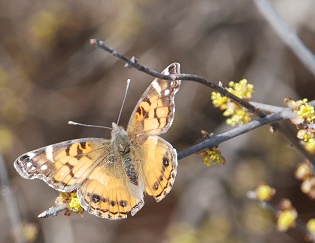
From a distance, a flowering elbow bush doesn’t look that impressive; the flowers are small and at this stage–with fewer than half open–it’s just the impression of dull gold that shows it’s flowering. Up close, the flowers are like tiny fireworks packed along the stems.
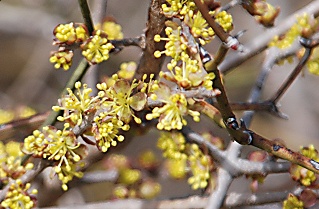
They’re also packed with pollen and nectar, attracting insects even before they open. Flies are the first customers at the flower bar:
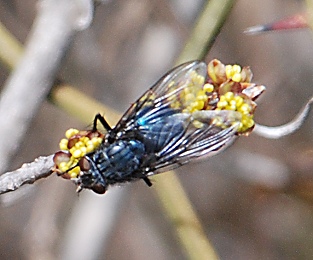
Many of the early flies are bluebottles, greenbottles, and an equally shiny bronze-bodied fly. They come in various sizes, and I don’t have the full ID on all of them. Later in the year, they’ll be found around dead things, trash and garbage, etc. Others are flies more commonly associated with flowers…some are bee or wasp mimics.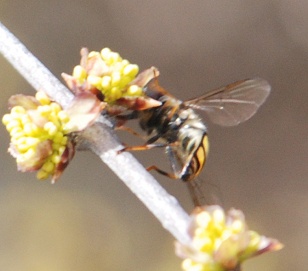
In addition to flies and the occasional butterfly, early elbowbush flowers attract early beetles, including the unwanted (but pretty) cucumber beetle.
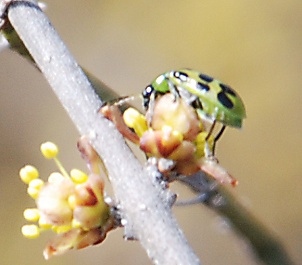
Later, bees will dominate the insects at the elbowbush and then wasps and moths like the Grapevine Epimenis. Elbowbush is thus a very important plant to support the insect population in early spring. Elbowbush is also a good browse plant for deer. Various vines grow over and through it without harming it, including the lovely Pearl Milkvine, Matelia reticulata, which–like all the milkweed relatives–supports some of the milkweed butterflies like Queen and Soldier. Later in the year, elbowbush produces abundant berries eaten by many birds, and when it’s dropped leaves in the fall, the dense twiggy cover provides a safe but sunny haven for wintering birds, where aerial predators can’t get at them.
And yet, to most people (including developers) elbowbush is just “brush,” a nuisance plant to be bulldozed away. Instead, it should be preserved where it exists, and planted where it doesn’t, as a native shrub of great value to wildlife and beautiful through much of the year.
Comment by Doranna — February 17, 2010 @ 1:38 pm
I love seeing your spring unfold while we’re still crunching around on deeply frozen ground…
Comment by Kip Colegrove — February 18, 2010 @ 8:24 pm
We finally had a thaw here in northeastern Ohio after snow, snow, more snow…did I mention there had been snow?
Like Doranna, I’m enjoying the jumpstart on spring your posts are providing. I do recollect snowfalls from my days in central Texas, but I also remember that spring came early compared to what we northerners were used to.
Comment by elizabeth — February 19, 2010 @ 12:02 am
The last two years, especially last year, local spring has been muted by drought. We have great hopes for the wildflowers this spring.
Comment by Abigail Miller — February 24, 2010 @ 12:26 am
Have you any idea if elbowbush is sold by any nurseries? I saw it in bloom last March at the Fort Worth Nature Center, 30 miles from here, but I don’t believe there is any on my property. Seems like it’s a native I could properly add.
(The city of Fort Worth had the incredible good sense, in 1913! to purchase 3500 acres of their upstream watershed to protect the city’s water supply. So now they have this native habitat, woods and bluffs and river and grass, right at the edge of town.)
Comment by elizabeth — February 24, 2010 @ 7:38 am
I don’t know if elbowbush is available commercially–I’ll check with the nearest native plant nurseries. Or I can send you the dried berries. According to Nokes How to Grow Native Plants of Texas and the Southwest, Forestiera pubescens is easy to propagate from either seeds or cuttings and is the species that also grows in north Texas and Oklahoma. Barnes & Noble lists this book and it’s really good (though I don’t have my mother’s green thumb.) Some of the plants are male; some female.
Comment by Becky Bender — April 4, 2010 @ 10:50 am
Elbow Bush (Forestiera pubescens) is on the list of those plants that will be available at the annual native plant sale at the Heard Wildlife Sanctuary in McKinney, Texas, on the weekend of April 10 – 11, 2010. A tip from someone who attends every year: only Heard members can shop on Friday evening, April 9, and some plants are depleted that evening. In addition, some plants listed on their website are not actually at the sale. They do a good job of providing native plants that cannot be found in the nursery trade, but I have found the list to be a “more than likely will have” and not a guarantee. See the Heard Musuem and Wildlife Santuary website for a complete list of plants. Becky in Celina